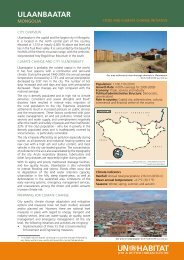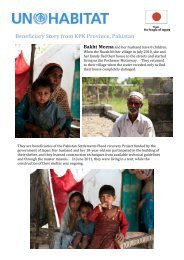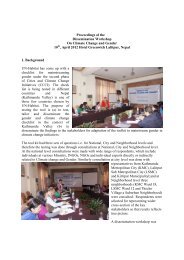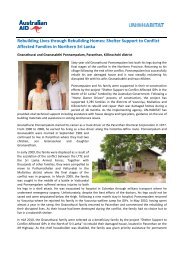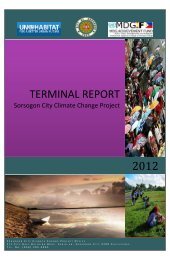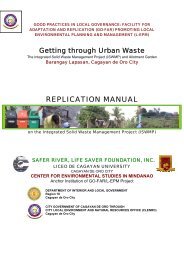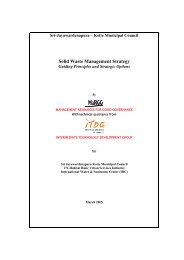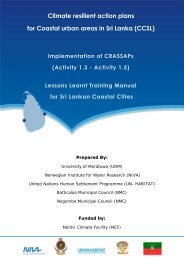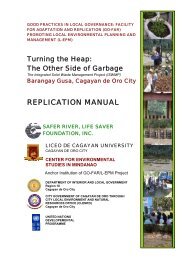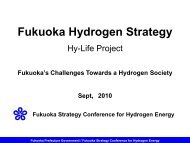Pakistan
Pakistan
Pakistan
- No tags were found...
You also want an ePaper? Increase the reach of your titles
YUMPU automatically turns print PDFs into web optimized ePapers that Google loves.
General Information• Area: 796,096 km 2• Population:• Capital:173.51 MillionIslamabad• GDP Growth Rate: 2 %• GDP per capita: 2,661 $• Urbanization: 33.5%Sources: <strong>Pakistan</strong> Economic Survey, 2009-10IMF, 2009
Current Status
Comparison of Energy Consumption by SourceSource: Hydrocarbon Development Institute of <strong>Pakistan</strong>
43%Energy Consumption by Sector(Total: 37 Million TOE)4%2%21%28%2%DomesticOther Govt.TransportAgricultureIndustrialCommercialIndustrial Sector takes the largest slice of national energy consumptionclosely followed by transport sector (28%) HSD consumption for tractors is notseparately available and is included in the transport section.(Source: <strong>Pakistan</strong> Energy Year Book, 2009)
Energy Mix in Power Generation (%age)Source: <strong>Pakistan</strong> Energy Year Book
Projection for Demand and Supply ofElectricity (2008-2010)No. Year Firm Supply(MW)Peak Demand(MW)Surplus/(Deficit)(MW)1. 2008-09 15055 19080 40252. 2009-2010 15055 20584 5529Source: Ministry of Water and Power
Renewable Energy Potential in <strong>Pakistan</strong>Energy SourceWindSolarBagasse CogenerationWaste to powerMini & small hydelPotential0.346 Milion MW2.9 Million MW1800 MW500 MW2000 MWInvestment Potential for the Renewable Energy: USD 16 billion dollarsSource: Alternative Energy Development Board
Gravity of the Challenge Today• Seriously worsening gap between Energy supply and demand• Non sustainability of fossil fuels (limited oil and gas reserves)• Spiraling oil prices• Lack of energy conservation culture• Compounding poverty with political fallout
Situation Analysis• <strong>Pakistan</strong> lacks integrated national energy security plan up till 2005.• Low per capita energy consumption with only 14 million BritishThermal Unit (MMBTU) as compared to 92 MMBTU for Malaysiaand 514 MMBTU for Japan.• Per capita energy consumption is a key development indicators of“quality of life” of the population.• Demand suppression strategy has been used which has perpetuatedunavailability of energy.• Unavailability of sustained and affordable energy to industry which hassuppressed economic growth and created declining tendency forindustrial investment in <strong>Pakistan</strong>.
Energy Conservation
Energy Conservation PotentialAnnual Savings US$ 3 billion• Industry 15 - 25%• Transport 15 - 20%• Agriculture 15 - 20%• Buildings 20 - 30%• Average 15 - 20 %
The National Energy Conservation Policy• The first ever National Energy Conservation Policy has beendeveloped and approved by Government in 2006• The policy provides a broad guideline to promote conservation in allsectors of economy
The Bill on Energy Efficiency and Conservation• The Bill is in the process of being promulgated
Building Energy Code of <strong>Pakistan</strong>The Building Energy Code of <strong>Pakistan</strong> is now being fine tuned forimplementation and enforcement
Encouraging Mass Transit• Launched private – public partnership based environmentfriendly CNG transport system for ten major cities of<strong>Pakistan</strong>
Some InterventionsIndustry• Preliminary Energy Audits 80• Detailed energy Surveys 50• Boiler/ Furnace Tune-Up 767• Combustion Analyzers 53• Burner/ Boiler Replacement Surveys 100• Electrical System Surveys 100• Steam System Surveys 47• Demonstration Projects 5Building (Promoting energy smart building culture)• Preliminary Energy Surveys 85• Detailed Energy Audits 54• Demonstration Projects 6• Building Energy Codes Ready
AgricultureSome Interventions• Preliminary Tubewell Audit 315• Detailed Tubewell Audit 553• Detailed Energy Audit of Municipality Pump sets 65• Tubewell Retrofits 462• Detail Energy Audit of Tractors 51• Operational Retrofits of Tractors 53• Demonstration Projects 2Transport• Establishment of Computerized Tune Up Centers 50• Auto Tune-Ups 120,000• Training of Automotive Mechanics 1500• Training of Workshop Owners/ Entrepreneurs 850Training/ Outreach/ Information• Professionals (Arch, Engr, Tech, Managers) Trained in Workshops 5200• Newsletter Circulation 10000• International Symposium 5• Women Trained Through Home Energy Conservation Program 10000
Development ProjectsCompleted:• Fuel Efficiency in Road Transport Sector Project• National Awareness Campaign on Energy EfficiencyOn-going:• Mass Transit CNG Bus Project• Standardization and Labeling of Appliances• Energy Conservation Fund (ECF• Provision of Technical Services & Energy Audits22
Energy Associated Policies• Natural Gas Allocation & Management Police-2005• Policy for Power Generation Projects-2002• Liquefied Natural Gas(LNG) Policy-2006• Liquefied Petroleum Gas (LPG)-2006• Petroleum Policy -2009• <strong>Pakistan</strong> Renewable Development Policy-2006• National Policy for Coal Development-2010 (In progress)
Policy Directions & Targets(2010-2015)• Energy Sector and its entities to be integrated under one umbrella.• Energy Conservation Bill to be enacted, and ENERCON to be aregulatory authority• Implementation of the approved National Energy ConservationPolicy on fast track• Private-Public partnership to promote EC by facilitating easy accessto appropriate technologies.• PM directive for strict implementation of EC measures in allGovernment Transport and Buildings (Residences, Offices forlighting and air conditioning purposes).25
Policy Directions & Targets(2010-2015)• Directive for all heavy energy consuming entities to have their ownenergy managers and develop EC plans for implementation.• Institution of National Award on Energy Conservation• Energy Conservation to be declared as an industry for appropriatefinancial & fiscal incentives
Policy Directions & Targets(2010-2015)• Financially and fiscally Promoting best practices which would be low costhigh return initiatives in various energy consuming sectors of economy• Development, implementation and follow-up on specific energyconservation projects as envisaged in the EE/EC Policy in various sectors ofeconomy• The “Conservation Resource” to be promoted as a low cost source of newenergy supply that can be developed in a comparatively shorter timeframe.It is usually easy to harvest and environment friendly27
The Way Forward• Private-Public partnership on EC being promoted by facilitating easyaccess to appropriate technologies.• Inculcation of Energy Service Companies (ESCOs) culture forpromotion of PPP• Implementation of the approved National Energy Conservation Policyon fast track• Mass awareness to sensitize various sectors of society to consideradopting EC options
The Way Forward• Strict enforcement of commercial activity timings• The Building Energy Code to be incorporated in the bye-lawsof the Municipal Bodies and Development Authorities etc.• Energy audits of existing buildings to be carried out by therespective organizations in collaboration with ENERCON.• The heads of the public and private sector organizations todesignate energy focal person/manager for ensuring adoptionof energy conservation & efficiency measures in theirorganizations.



